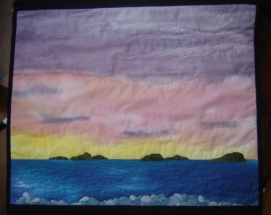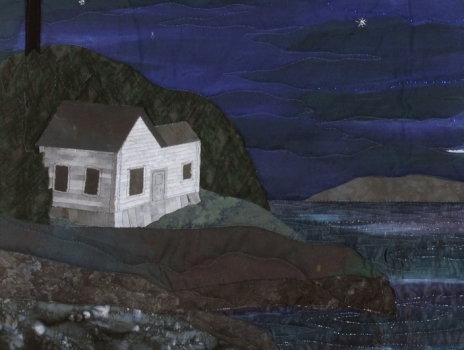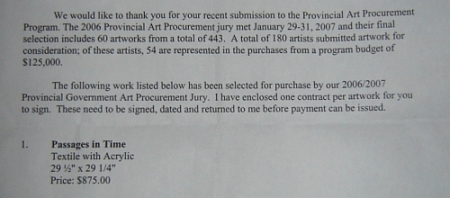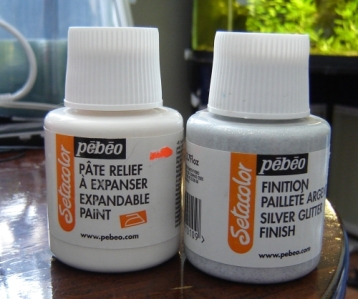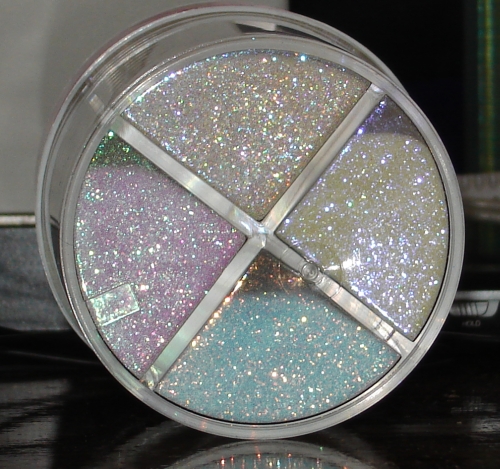Over the last few days, I’ve been preparing summer stock for two of the shops I supply. Most places around here like to be in full swing by mid-May, so I generally aim to have things in their hands by mid-April.
This week has been a week of birches. I use hand-dyed cotton fabric (low water immersion dyes using Procion MX, in case you’re interested) for the backgrounds and fussy-cut the pieces for specific spots in the fabric. Wastage is minimal, however, as the smaller works (4.5″ squares, for instance) can make excellent use of sections of fabric that would look just plain wrong for larger backgrounds. Below are thumbnails of two of the pieces used:


The trees are a commercial (ugly as sin) fabric that, when cut into strips, looks not bad at all. I cut the strips freehand with a rotary cutter (yes, it’s tricky to get things even) and tend to cut from several different pieces of the same fabric so that the trees don’t all end up having the same curvature or the same repeats in the fabric print.
As you can see below, the background with the strips laid in place:

These will be cut into three panels each when finished, hence the somewhat odd arrangements of tree trunks.
When working in a series like this, I also streamline the process by cutting out fifty or a hundred trees at once and then arranging them afterwards to suit the individual composition. I’ve discovered that I don’t really like being a one-woman assembly line, churning out the same piece time after time. I prefer to work on a reasonable number of pieces that are of a similar theme in one go. This allows me more variety, less stultification and, most importantly, gives each piece the attention and space it needs to be original as it grows and evolves.
After laying the trees in place, I then hand-shade the trees to add curvature to the trunks. As you can see below, the effect is not only one of added depth, but also adds drama to the composition and enhances the effect of the trees moving towards the viewer, off the background. The work is built up another layer from the furthest visual point.
I’ve spent several days penning in the details on these tree pieces and can say with certainty that if the devil isn’t in the details, he sure as hell rejoices in their existence. Small, refined motions of shading for days on end are not good for the body.
A shot of two smaller pieces showing the shading(these were two of my favourites from the week)

The effect is even visible from a distance in the larger pieces:

It’s interesting to see the contrast between shaded and unshaded trees in the same piece. The first shot below is half-shaded. The second shot is with shading complete.


Today’s task is to pen in all the branches, layer the piece with stabiliser and push the whole batch towards completion. To that end I have to:
- add branches
- stabilise panels
- cut panels into tryptiches
- prepare backings and attach hanging devices
- layer panels with backing and centre stiffener (plastic canvas is a wonderful stiffener for such things; inert, waterproof, doesn’t stain and won’t kill a sewing machine if you accidentally or purposefully sew through it. Cheap, too.)
- stitch edges
- attach cording
- apply glue
- apply foil for leaves (Foiling is always the last step for these pieces.)
The result will be a variation on this (apologies for the rotten picture):

With details looking like this (again, bad picture. Colours wrong. Sorry. Will photograph the current series properly when completed!):



And some of the smaller pieces from a past rendition of this idea:


So I’m off to work. Proper pictures will follow…..
a quickr pickr post
Read Full Post »





















